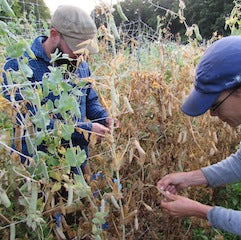 Every time we sow, we are not only making gustatory or aesthetic choices, but also serious political and environmental decisions. That’s dozens of big decisions in every salad bowl! But, with some basic knowledge of plant breeding, it’s not hard to stay informed and decide which sort of seeds line up with your personal gardening values. Below are three important seedy vocabulary terms - Open Pollinated, Heirloom, and Hybrid - to help every gardener navigate the sea of seed catalogs that will soon flood our mailboxes.
Every time we sow, we are not only making gustatory or aesthetic choices, but also serious political and environmental decisions. That’s dozens of big decisions in every salad bowl! But, with some basic knowledge of plant breeding, it’s not hard to stay informed and decide which sort of seeds line up with your personal gardening values. Below are three important seedy vocabulary terms - Open Pollinated, Heirloom, and Hybrid - to help every gardener navigate the sea of seed catalogs that will soon flood our mailboxes.
 Ken has written extensively about the big-picture implications of our seed choices and why here at the Seed Library, we choose to fill the pages of our own catalog exclusively with open-pollinated varieties. To learn more, take a look at his articles:
Ken has written extensively about the big-picture implications of our seed choices and why here at the Seed Library, we choose to fill the pages of our own catalog exclusively with open-pollinated varieties. To learn more, take a look at his articles:
- Which Way Do You Sow: how to vote with your fork from seed to plate
- Glossy Garden Porn: garden reality versus glossy seed catalog fantasies
- Worldwide March Against Monsanto: why this bio-tech giant inspires tireless global protest
- Giving Thanks to the Food Fighters: more on why we fight GMOs
Open Pollinated or OP refers to any seeds where pollination occurs without limitations on pollen flow between individual plants. The pollen can cross from one plant to another via wind, water, pollinating insects and birds, or even humans. OP plants are more genetically diverse (than hybrids), over time accumulating qualities that make them better adapted to the local climate they are grown in. They tend to have variation within a plant population, but saved seeds remain true to type, growing up the same as their parent plants.
Some varieties cross-pollinate (via the routes described above) and thus have isolation requirements to keep varieties within the same species true to type. For example, two Broccoli types planted adjacent to one another will inter-breed and the next generation from their seeds may express a mix of traits from both varieties. Other species are self-pollinators, which means male and female parts of the plant are contained within one flower and since they pollinate themselves, isolation is of little or no concern.
Heirlooms are a subset of OP seeds: all heirlooms are open-pollinated, however not all open-pollinated varieties are heirlooms. It’s a term coined in the 1970s and popularized in the 90s as a way of showing that some open-pollinated seeds are cherished and passed down from generation to generation the way a family carpet or painting might be. An heirloom seed or variety (not just tomatoes!) is one that has been grown within a family or community or region for a period of many generations. They "grow true," meaning that gardeners can continue to save seed from the variety and grow plants with consistent characteristics year after year. The debate over heirlooms is how old is old enough to qualify as an heirloom. We consider a variety that has been grown for 50-100 years an heirloom. Some of these are family heirlooms--such as Hank's X-tra Special Baking Bean and Upstate Oxheart Tomato--which were donated to us by individuals. Others are commercial heirlooms, seeds that have been commercially available for at least 50 years, though we don’t know the seed’s story before it was offered in a seed catalog. Some, like Jenny Lind Melons, are regional heirlooms, grown by many gardeners throughout a region for many years.
Heirlooms carry not only family and cultural history, but genetic diversity: often selected for the combination of sensory pleasures like tastes, looks, fragrance, and environmental resilience: disease, pest, frost, or heat resistance, for example.
Hybrids are the offspring of a controlled cross between two genetically different parent plants of the same species resulting in a first generation plant (F1) with some characteristics of both parents. Hybrids are usually developed for mono-crop and industrial farming purposes like shipability, mechanical harvesting, high yield (requiring high chemical inputs), uniformity, and shelf life. Not all seed catalogs tell you which varieties are hybrids. One clue is if it says F1, you know it's a hybrid.
We don’t sell any hybrid seeds. That’s because we want you to be able to save seeds from year to year, and you can’t do that with a hybrid. Hybrid-saved seeds will grow again, but will not grow “true to type” and will be weaken in the second generation.
We do, however, have some contemporary heirlooms whose best qualities have been untangled from their hybrid fore-bearers. Bridge to Paris peppers are one example; selected over successive seasons out of hybrid La Paris, this variety's deliciousness has only improved.
For more helpful seedy vocabulary for home gardeners, take a look here: Oh Say Can You Seed?





